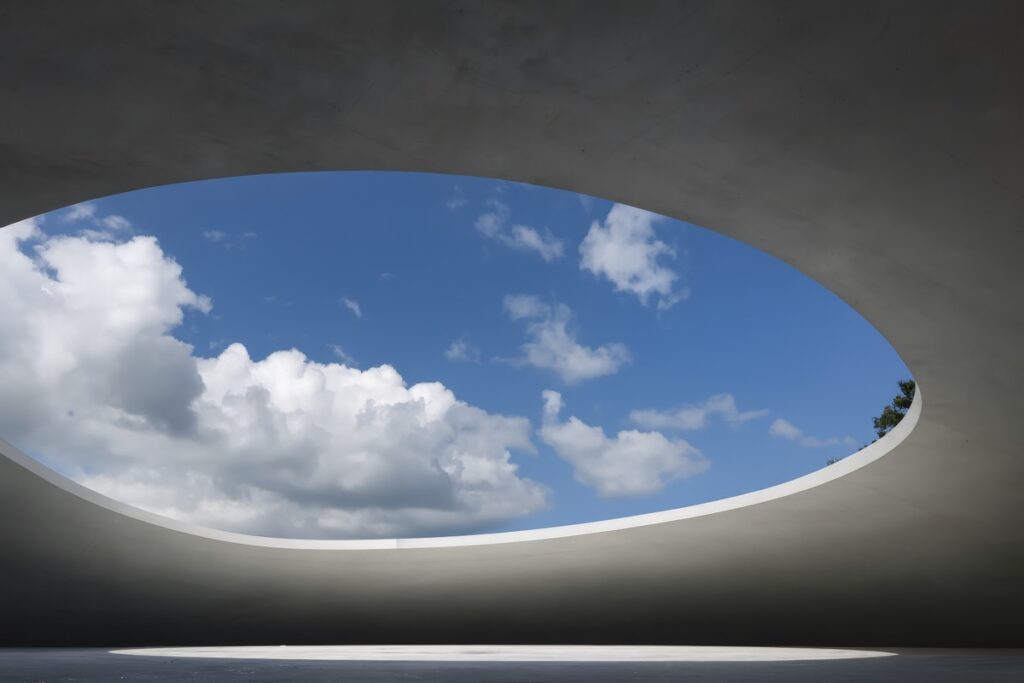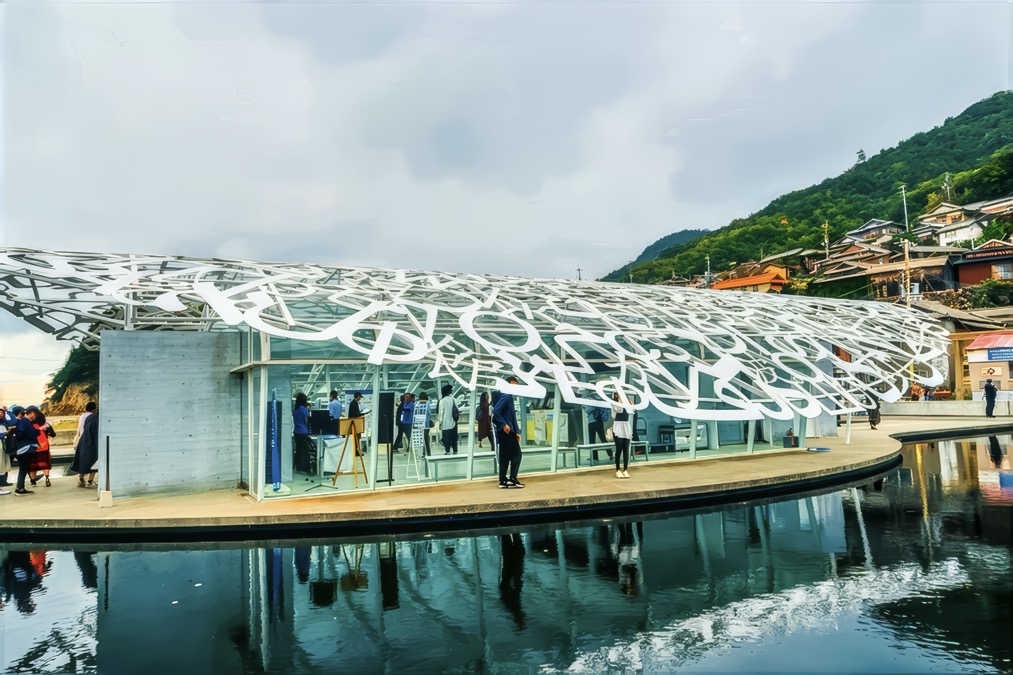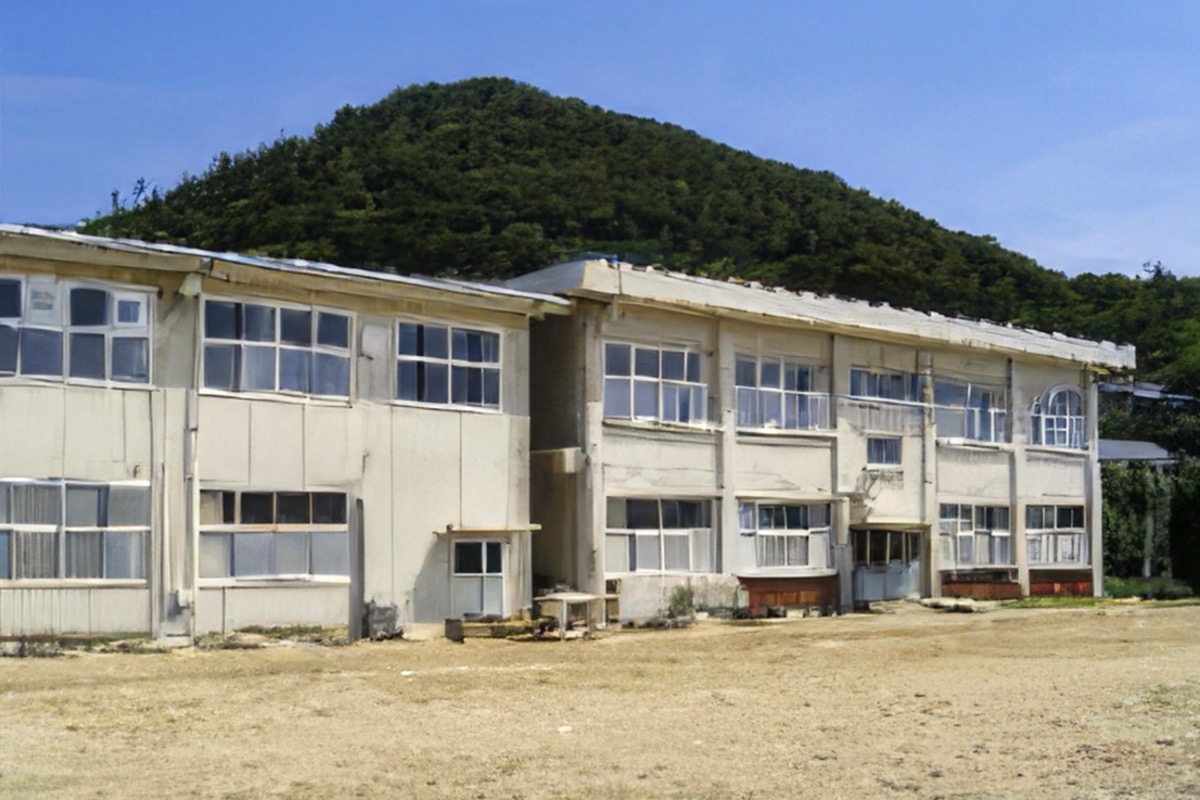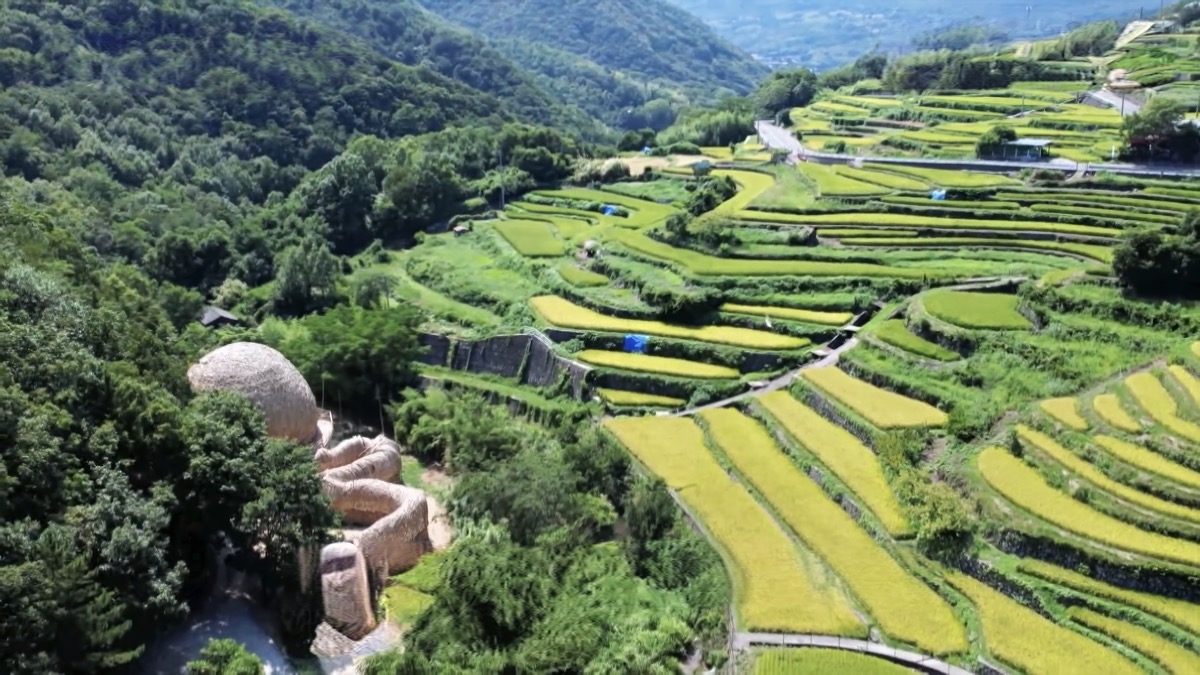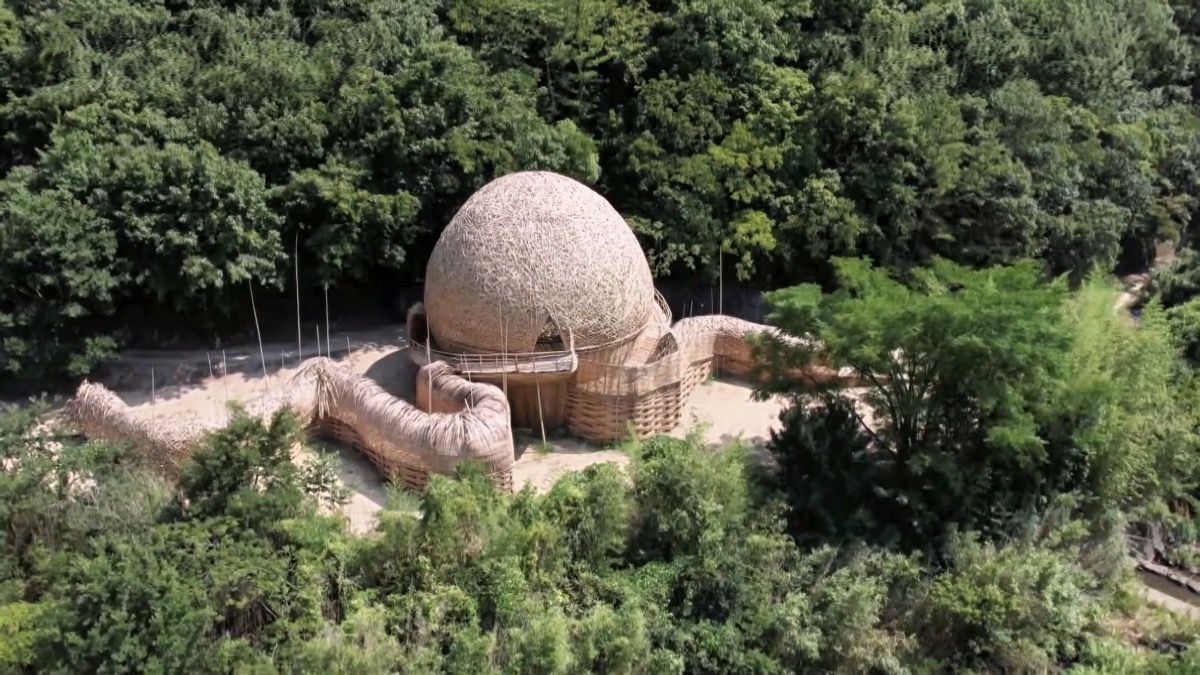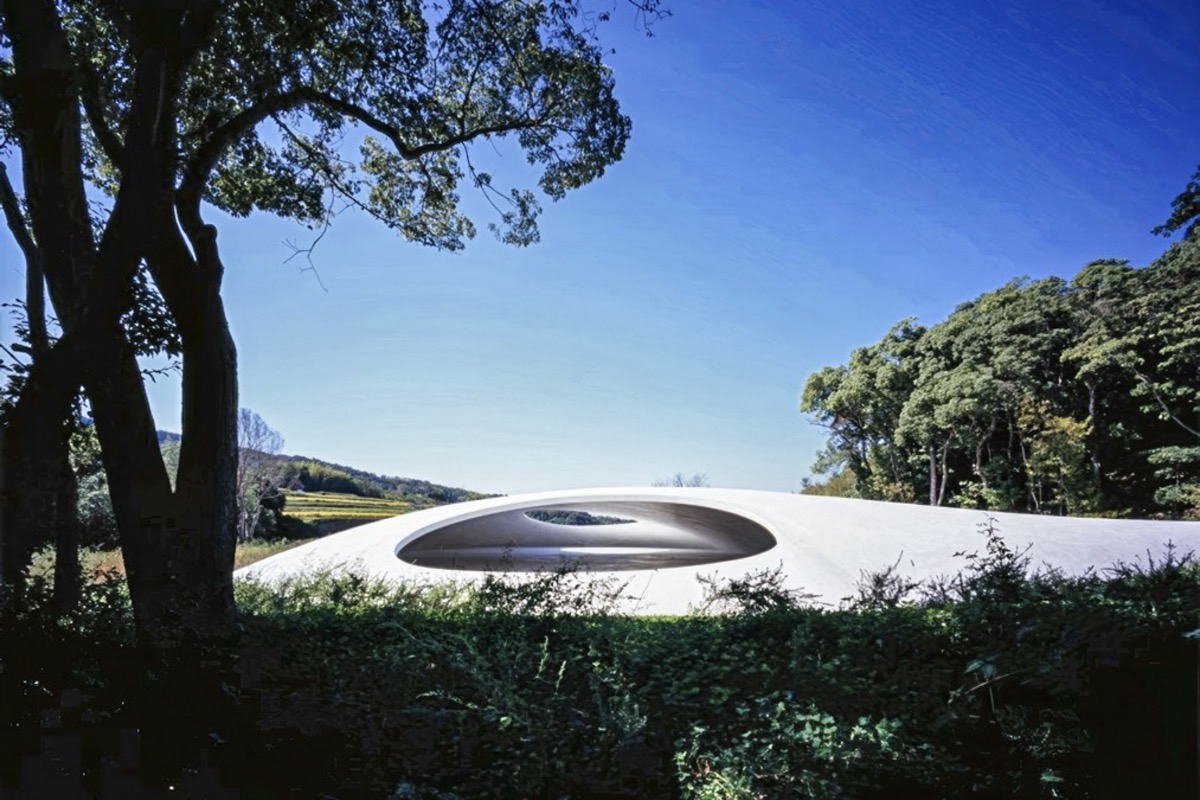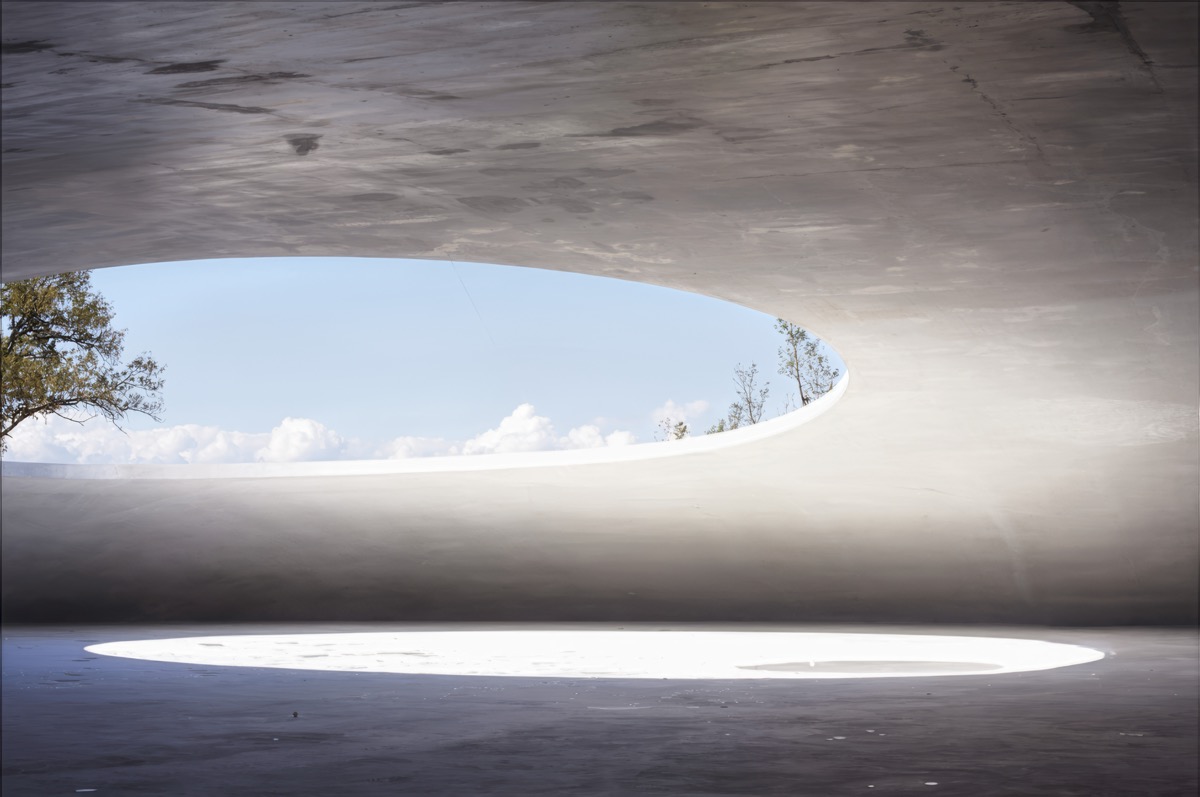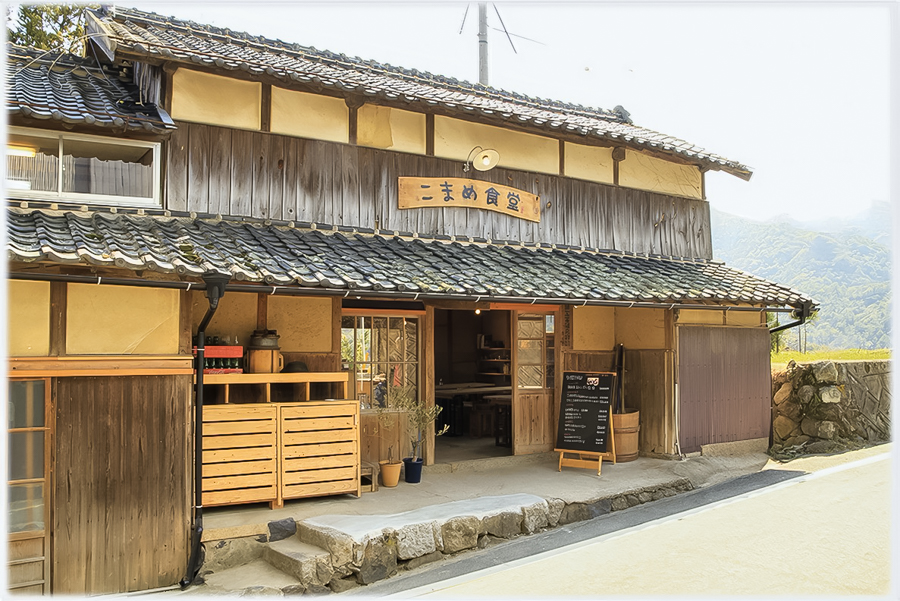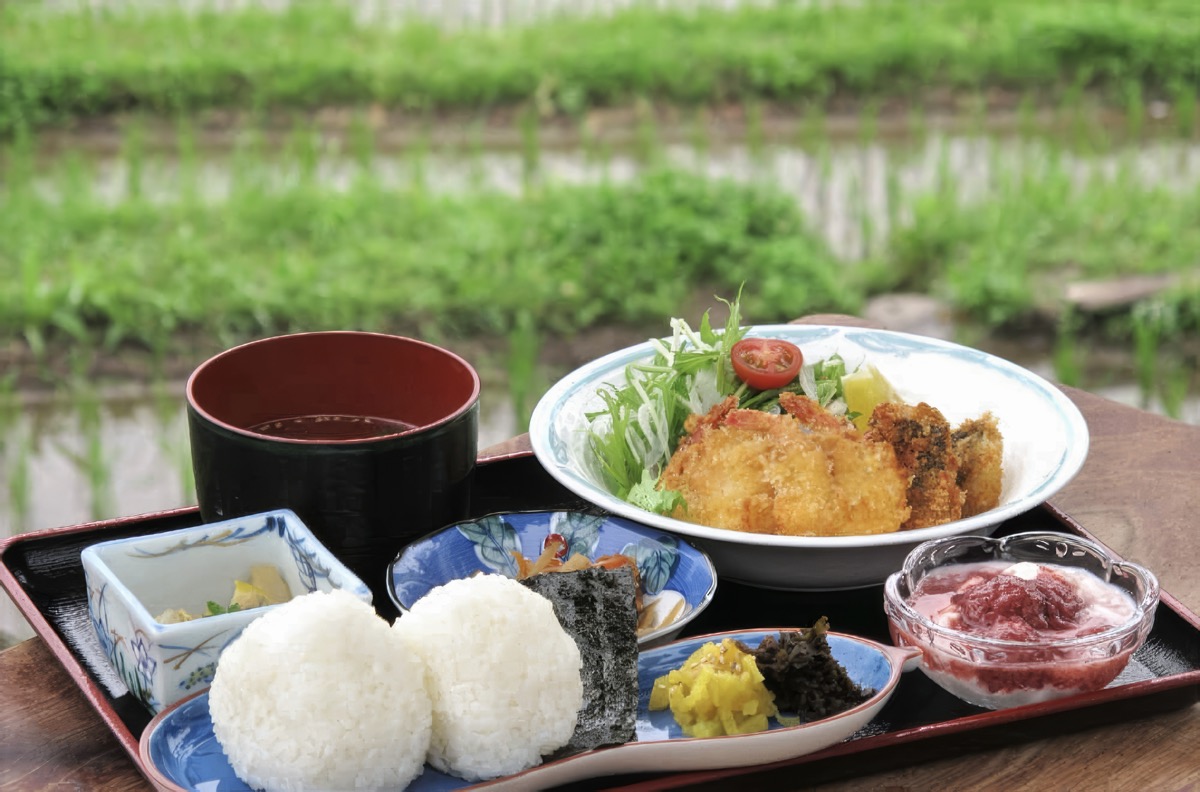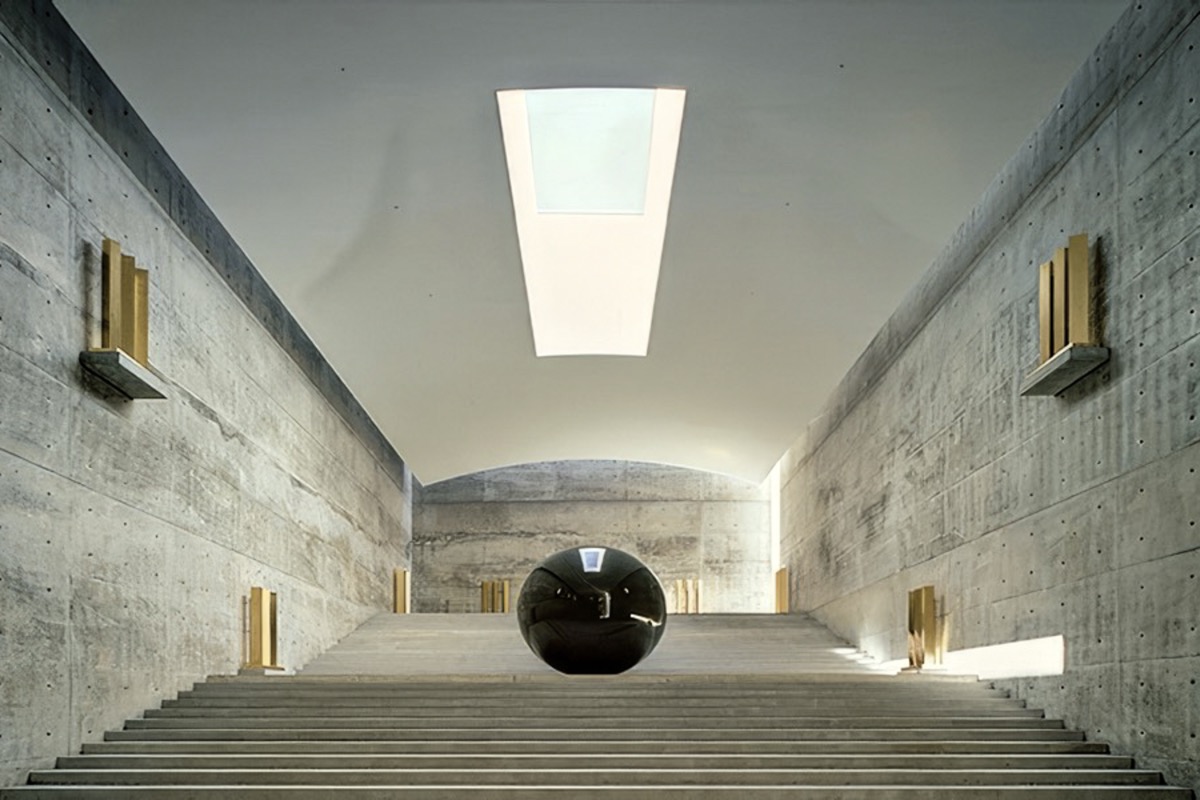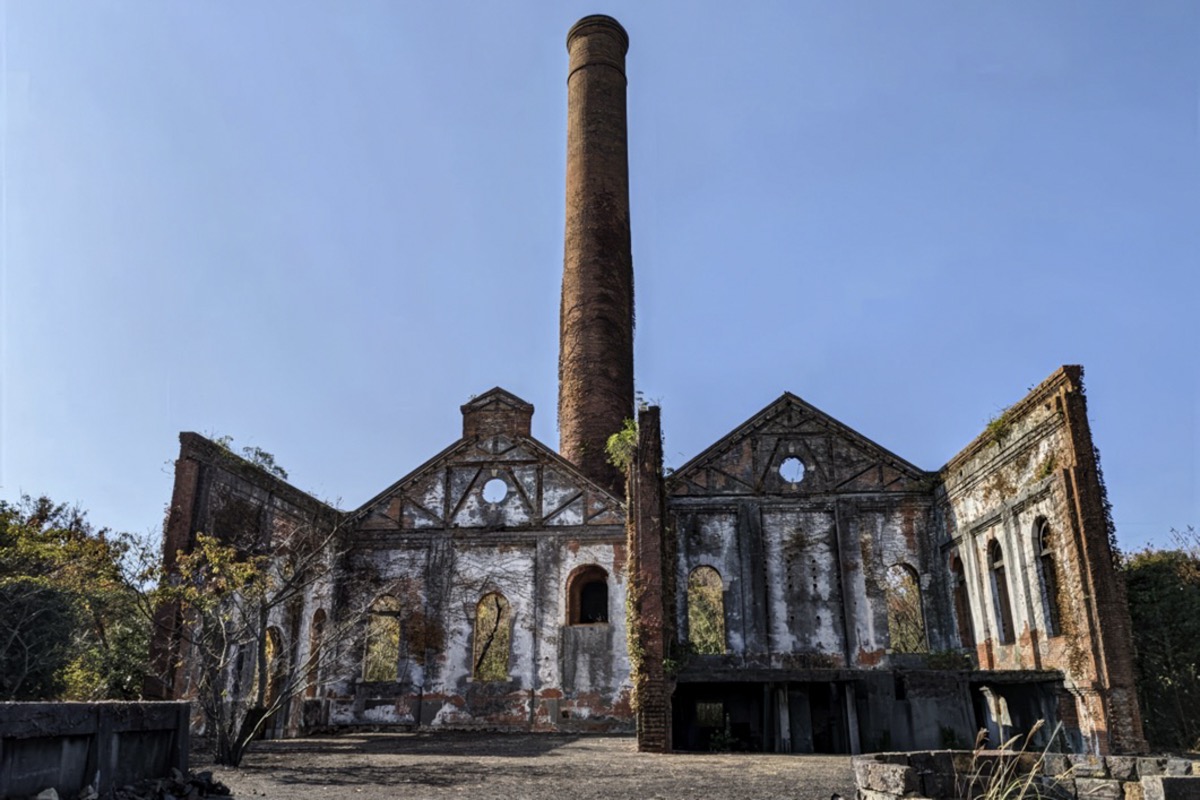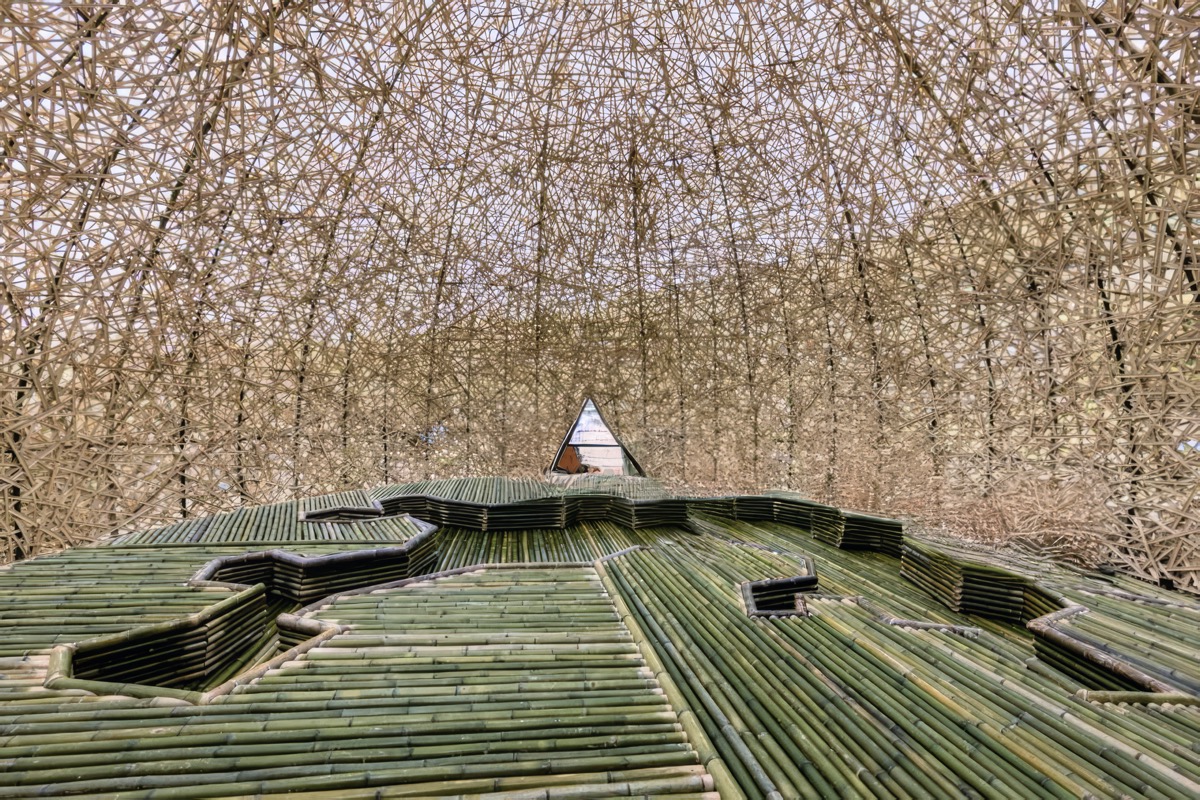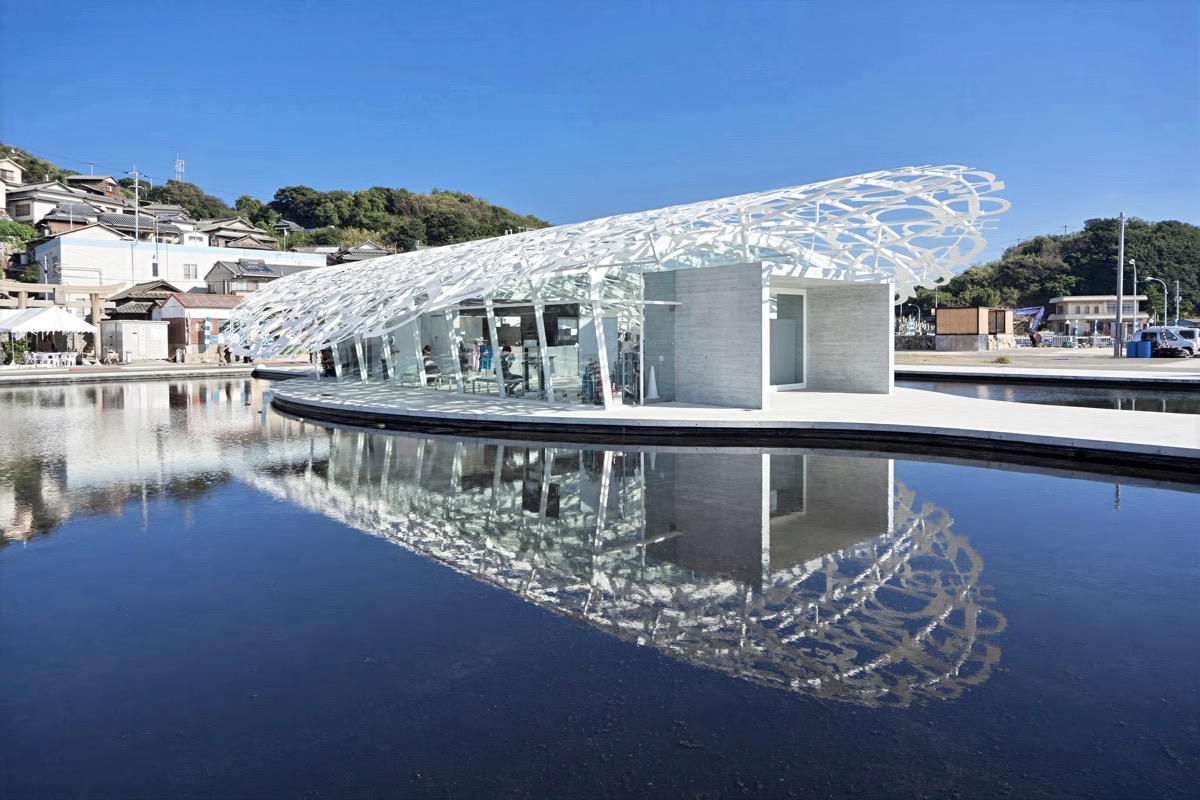Ogijima, a short ride from Takamatsu, once seemed to be emptying out. After the first Triennale, newcomers began to arrive. In 2014 the shuttered elementary and middle school reopened. A private library opened the same year and quietly became a desk where people asked how to move and how to stay. Living had more than one shape again. There were returnees, first-timers, and families who split their weeks between city and sea.
At the pier, Jaume Plensa’s “Ogijima’s Soul” greets each boat. The pavilion’s white canopy is cut with letters; light falls through them and drifts across the floor and the water. You step beneath it and feel your breathing ease.
Ferries run from Takamatsu to Ogijima, often via Megijima, in about forty minutes. Sailings are limited and change with season and weather. Check the latest timetable before you go.
https://meon.co.jp/
| Service No. | Departs Takamatsu | Arrives Ogijima | Notes |
|---|---|---|---|
| 1 | 08:00 | 08:40 | via Megijima, about 20 minutes transfer |
| 2 | 10:00 | 10:40 | same routing |
| 3 | 12:00 | 12:40 | same routing |
| 4 | 14:00 | 14:40 | same routing |
| 5 | 16:00 | 16:40 | same routing |
| 6 | 18:10 | 18:50 | same routing |
| Takamatsu to Megijima takes about 20 minutes on each sailing. Timetables vary by season and weather. Check the latest official schedule. https://meon.co.jp/access | |||
The draw is not only finished work. On Shodoshima, the Taiwanese artist Wang Wen-Chih asked for bamboo and time. Over about forty days a domed chamber took shape from some four thousand stalks, braided by Wang’s team, local residents, and volunteers known as the Koebi Corps. The dome was beautiful. The making was the heart of it. Talk comes easier when hands are occupied. People who had not met a month earlier learned one another’s names by passing and bending lengths of bamboo.
The Koebi Corps does not disappear when the banners come down. If the festival claims a hundred days, the year still leaves about a thousand. Those days belong to repairs, tours, care, and the long translation of the word art into the habits of daily life.
Anyone can join the Koebi Corps, even for a single day. Giving back a day of your trip is a Setouchi specialty.
Teshima once held one of Japan’s largest illegal dumps of industrial waste. Years of citizen action and cleanup followed. From that history came the Teshima Art Museum by Rei Naitō and Ryue Nishizawa. The building is a white shell open to sky and wind. Light drifts in. Water gathers in tiny beads from the floor and wanders. Sitting there teaches a simple lesson. Renewal is not always addition. Sometimes it is a re-knotting of attention to place, so that what was present all along can be felt again.
The past does not vanish. The island chose to walk forward while carrying it, and people now come from around the world to learn what that looks like.
Boats reach Teshima from Takamatsu, Uno, and Naoshima. Museum entry is often by timed reservation. Leave room to wander the rice terraces before or after your slot.
Change Four: A Hundred Festival Days and a Thousand Ordinary Ones
Value does not end when the calendar does. In Nakayama on Shodoshima, Komame Shokudō serves rice balls made from the paddies outside the window. On Ogijima a newcomer’s bakery and a café beside the library have become anchors.
Compliments from travelers travel farther than they seem to. Beautiful, delicious, well done. Those words find their way to farmers and fishers and become courage to carry on with work that takes time and care. Landscape, food, and livelihood begin to support one another instead of standing apart.
Weekday mornings are gentle. Hours shift with the seasons. Check each place’s most recent updates before you sail.
Change Five: Outsiders Become Part of the Family
No island greeted the Triennale with a single mood. Doubt was reasonable at first. Who would come here, and why. Then people watched visitors return for the very things locals had treated as background. A bend in a harbor wall at dusk. The way a lane narrows and opens.
Attention turned into a mirror. Pride rose, not as a slogan but as a working energy that carries into the next task.The Triennale does not simply place objects. It helps write stories with the people who live with them after the season ends.
Small Islands, Lasting Architecture and Art
The Setouchi Triennale does not feel like an event that simply places artworks; it feels like a way of nurturing the islands’ stories together.
-
Naoshima: Chichu Art Museum A building set mostly below ground that admits and measures light with unusual care. Essential for understanding the region’s language of space. Reservations and separate admission often apply.
-
Inujima: Seirensho Art Museum A former copper refinery turned into a study of industry and nature. Red chimneys and black slag brick hold the horizon and keep time.
-
Shodoshima: Wang Wen-Chih’s Bamboo Dome A building set mostly below ground that admits and measures light with unusual care. Essential for understanding the region’s language of space. Reservations and separate admission often apply.
-
Ogijima. Ogijima’s Soul Letters become roof, shade, and shadow. Your first step off the boat becomes an overture.
Field Notes for Travelers
Season
The festival unfolds in three chapters. Islands and sites keep different open days. The official calendar is essential.
https://setouchi-artfest.jp/en/about/
Passports
Festival passes cover many works. Some marquee sites, including Teshima Art Museum and Chichu, require separate timed entry.
Getting around
Ferries run from Takamatsu to Naoshima, Teshima, Megijima, and Ogijima. Uno on the Okayama side connects to Naoshima. Schedules shift with season and weather. On the islands, pair the first boat of the morning with a rental bicycle and local buses.
Avoiding crowds
Cross on the earliest ferry you can. Plan popular sites around your reservations. Moving counter to the clock helps.
Etiquette
These are living villages. Ask before photographing homes. Carry your trash. Give fields and fishing gear respectful space. Volunteers and staff are reliable guides. Take their advice.
A Two-Day Outline from Takamatsu
-
Day One: Ogijima with a Megijima stop Walk beneath Plensa’s pavilion, wander the lanes and small installations, and if time allows continue toward the lighthouse. On the way back, stop at Megijima before returning to Takamatsu.
-
Day Two: Teshima with an evening on Shodoshima From Ieura, ride up to Karato-oka and center your day on the museum reservation and the terraces. Toward evening, cross to Shodoshima for the bamboo dome as the light softens.
If time opens further, leave from Uno and visit Inujima. The refinery’s chimney, the slag, and the flat line of sea leave a long afterimage.
Is Art Magic or a Matc
Population has begun to return. Ties have formed. A hard history has been reworked into a place for learning. Life outside the festival days feels larger. Outsiders begin to read as extended kin. None of this is a cure. Art does a humbler thing. It lends a lamp. It makes use of paths that already exist. It turns praise from elsewhere into local confidence, which turns into work, which becomes future.
On your next trip, look for what is already there. The overlooked, the ordinary, the almost lost. Setouchi suggests that many treasures are modest and close at hand, waiting for time and a bit of light.
Setouchi Triennale 2025 Fall Schedule
Setouchi Triennale 2025 : https://setouchi-artfest.jp/en/
| Area | Closed Days |
|---|---|
| Naoshima | Generally Mondays* |
| Teshima, Inujima | Generally Tuesdays* |
| Megijima, Ogijima, Shodoshima | Wed, Oct 22; Wed, Oct 29 |
| Oshima | Sat, Oct 4; Wed, Oct 22; Wed, Oct 29 |
| Honjima, Takamishima, Awashima, Ibukijima | Thu, Oct 23; Thu, Oct 30 |
Appendix. Getting from Tokyo to Takamatsu
| Mode | Route | Approx. Time | Approx. One-way Cost | Notes |
|---|---|---|---|---|
| Flight + Airport Bus | Haneda Airport → Takamatsu Airport (ANA/JAL about 1 h 20 m) → airport bus to Takamatsu Station (about 40 m) → 5-minute walk to Takamatsu Port | About 2 h 20 m plus waiting time | From about ¥15,000 | Fastest and convenient; easy with luggage. |
| Shinkansen + Limited Express | Tokyo Station → Shinkansen to Okayama (about 3 h 30 m) → Marine Liner to Takamatsu (about 1 h) → 5-minute walk to the port | About 4 h 40 m | From about ¥17,000 | Good views; one transfer. |
| Overnight Bus | Tokyo (Shinjuku/Shibuya, etc.) → Takamatsu Station (about 9–10 h) → 5-minute walk to the port | About 10 h | About ¥7,000–¥12,000 | Cheapest; late-night departure, morning arrival; saves a hotel night. |
| Car (self-drive) | Tokyo → via Tomei/Meishin/Sanyo Expressways and the Great Seto Bridge → Takamatsu | About 9–10 h (about 750 km) | Tolls about ¥15,000 plus fuel | Good for drivers; high flexibility. |
Lately I have changed how I choose where to travel. I used to pick places I wanted to see and plan for the best season. Now I start with a different question. Does this place actually want visitors right now. If the answer feels like no, I look somewhere else.
The shift began in Kyoto in 2019. I traveled Japan with my French friend. He said he wanted to go to Kyoto first. That made sense for a first trip. Tokyo if you are after the fashionable present. Kyoto if you are drawn to tradition. I love the distinctly Japanese air that city gives off.
Because we chose peak season the crowds were extreme. Most people around us seemed to be visitors from abroad. At Kyoto Station the taxi line stretched on and on. When we finally got a cab I said Kyoto really is popular with people from overseas. The driver answered in a tired voice. There are too many tourists, he said, and ordinary life cannot function. Trains, buses, and taxis are jammed with suitcases. Even when you get on you sit in traffic. He said some visitors slip into private homes to take photos and some even pluck flowers from small gardens.
The scene that shocked us most was a group of foreign tourists chasing a *Maiko who was politely refusing while they tried to record a video with her. Some even reached out and touched her kimono without permission. She tried to get away at a half run and it turned into a kind of game. People nearby joined in, smartphone and cameras up. Strangers spoke to her in languages she might not have understood and laughed. I kept thinking how frightened she must have been. Each time we saw something like that, the thrill of being in Kyoto thinned out.
This is what overtourism looks like. Can a city keep welcoming visitors without losing the fabric of daily life. If not, how do you get that life back. I understand the confusion. In Paris I feel it every day. The country keeps trying new measures for one of the world’s great tourist cities, but ordinary citizens give up pieces of their days all the same.
I walk to work and end up in the background of a hundred selfies. If someone glares there is nothing I can do. If I step out of one frame I wander into another. Sometimes I wonder how many photos of strangers around the world include me without my knowing it, and the thought unsettles me. When a couple stops in the middle of the street for wedding photos, traffic locks up again. It is their once in a lifetime day, and even the blaring horns seem to move them. There are other things. Noise at night. No matter where you go or where you try to eat, there is always a line. I travel too. I do not want to feel negative toward visitors. Still, the small stresses pile up.
Is there an answer. During the Paris Olympics the city set up zones where only residents with proof could pass. Should we do that again. Charge for the rest. That worked because it had an end date. People accept rules more easily when they are temporary.
In a strange way we were lucky in 2019. The next year the pandemic began. News broadcasts showed Kyoto with no one in the streets. It felt improper to think it, but I caught myself wanting to go then. Now that the world has reopened, the visitor numbers are said to be the highest ever. What feels hard in Kyoto or Paris has become a shared problem for destinations everywhere.
So where to go. I am drawn to places like the Seto Inland Sea, where people seem glad to welcome visitors. Many come for art, and the towns have grown ways to host them without losing their own rhythm. The noise does not swell beyond measure. Travelers and residents share the same view gently. I hope that balance holds.
Places where guests feel welcome and hosts can still feel at ease the next morning seem to be shrinking in number. That is why they matter more. We should take care of them. We should move a little slower. We should leave with the sense that the world can be kind if we let it.
*Maiko are apprentices in Kyoto’s traditional arts, and geisha, called geiko in Kyoto, are the fully trained professionals they become. They dance, play shamisen, host with grace, and keep old etiquette alive. Some visitors mistake them for prostitutes. They are not. They are respected artists.


